
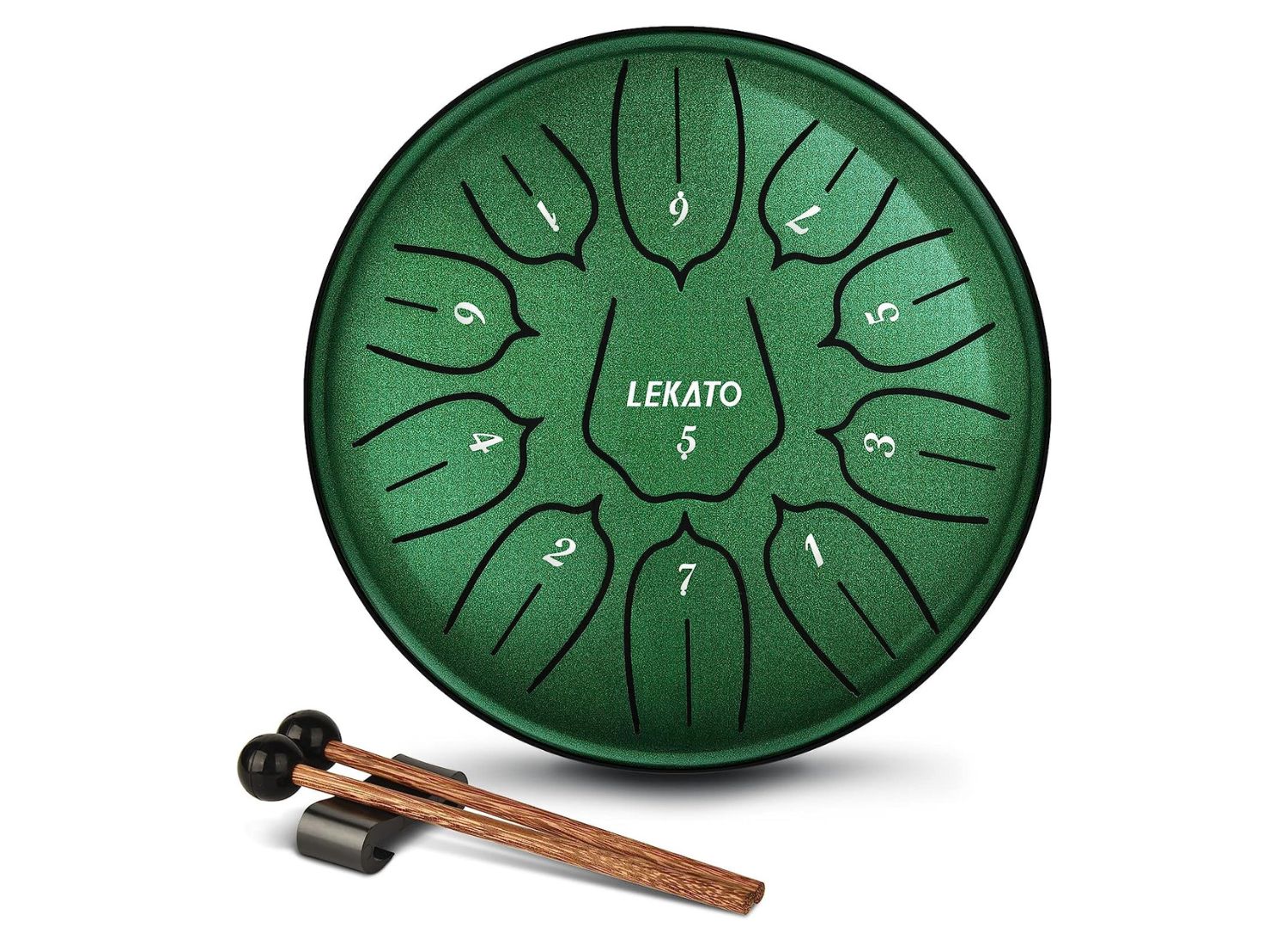
The LEKATO Tongue Drum is a beautifully crafted musical instrument that offers a unique and captivating sound. Made from high-quality steel, this drum features 11 tongues, and each tongue produces a distinct pitch, allowing players to create a range of beautiful and harmonious melodies.
Measuring six inches wide, this musical instrument features a compact and portable design, making it perfect for musicians who want to create music on the go or perform in intimate settings. Since this percussion instrument is exceptionally versatile, you can use it for yoga meditation, spiritual ceremonies, and more. Plus, it comes with a pair of drum mallets, and four finger picks that allow you to produce clear tones that are rich in depth and resonance. Because of its durability, beautiful design, and pristine sound quality, this tongue drum stands at the top of our list.
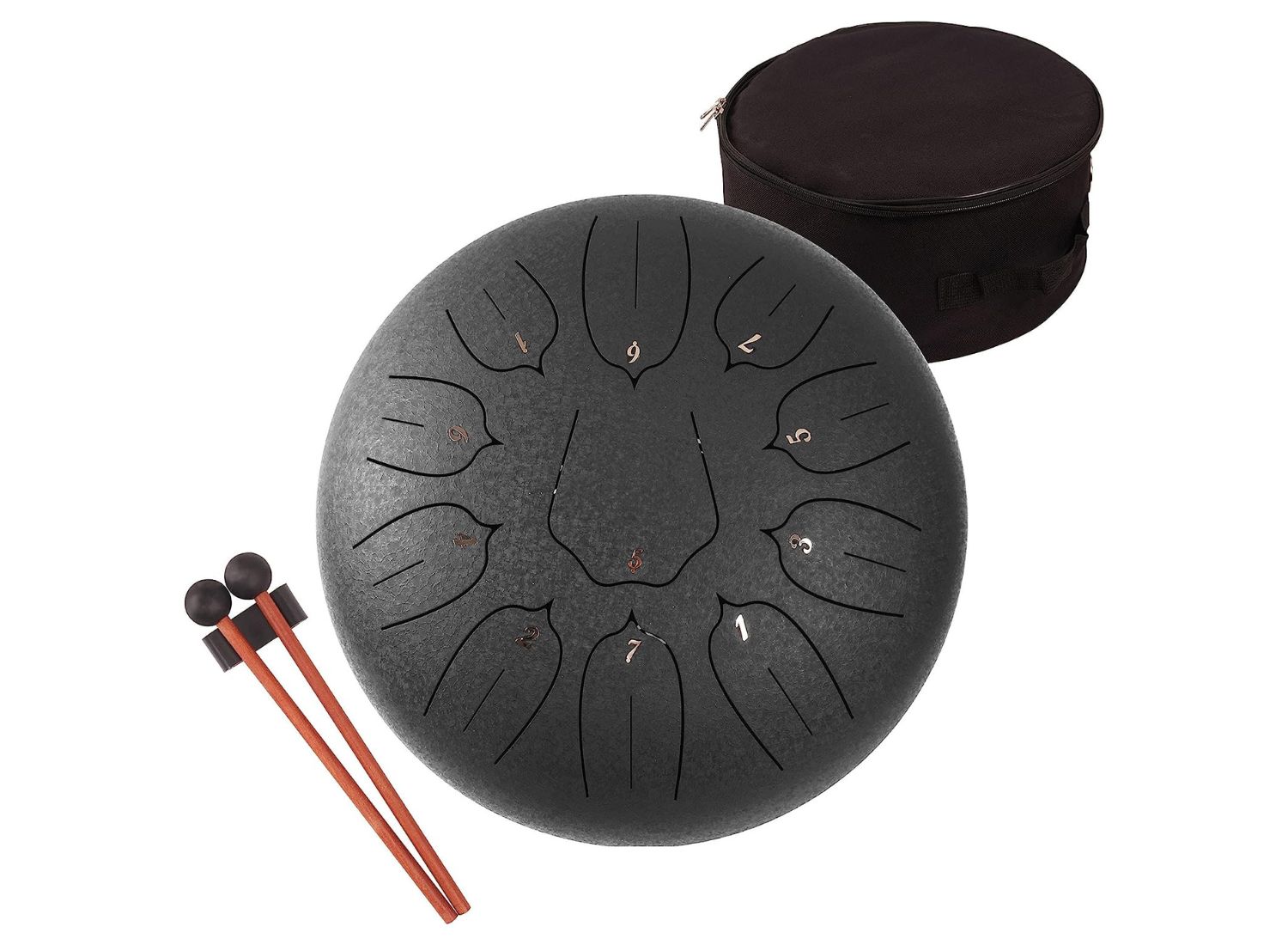
The LOMUTY Tongue Drum is the perfect way to express yourself through music. This product comes pre-tuned to the mixed C major with three different octaves and 11 tones consisting of pentatonic scales, which allows you to create raw but enchanting music that’ll touch every heart within earshot. Available in two different sizes, this tongue drum is handmade from steel-titanium alloy and features advanced paint coating, which makes it durable and corrosion-resistant. Thanks to its slip-resistant backing, you don’t have to worry about the drum slipping off while you’re jamming out. With your purchase, you’ll get a pair of mallets, a music book in English, notes stickers, finger picks, and an instruction manual that will help you master this instrument within days.
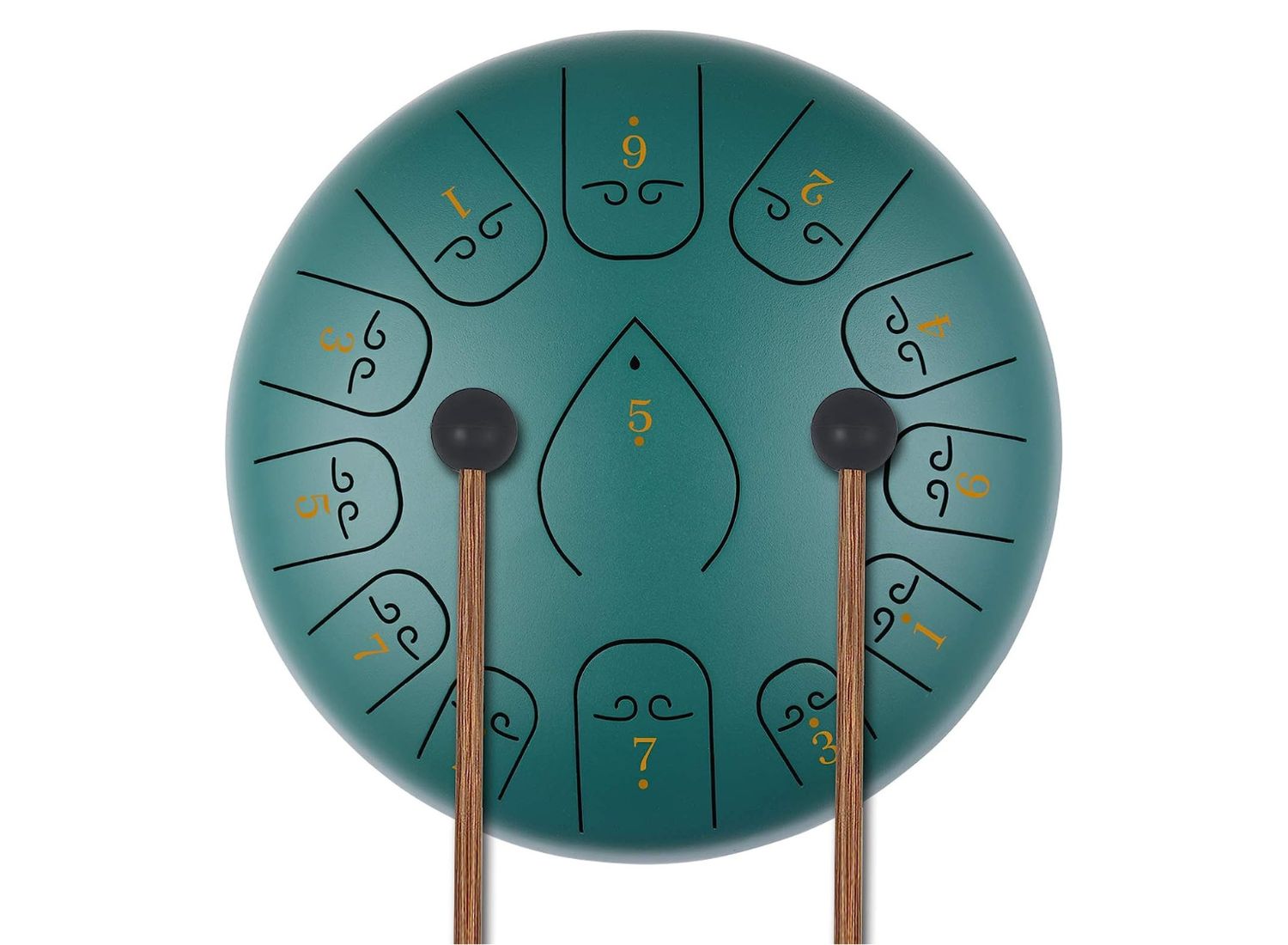
With the KUDOUT Tongue Drum, you can take your music skills to another level. Designed with meticulous cuts, this product had steel titanium construction and a protective lacquer coating that protects it from nicks, chips, and scratches. This tongue drum is hand-tuned for superior sound quality — and features 13 notes in C major, allowing you to experiment with different musical genres, including jazz, rock ‘n roll, pop music, and more! You can tap it with your hand to create a soft beat or use mallets to get an even more complex sound.
This percussion instrument comes with two steel drum mallets, one mallet holder, six drum finger picks, a tone sticker, and a music book. Thanks to the included travel bag, you can easily store your instrument or take it with you on the go!
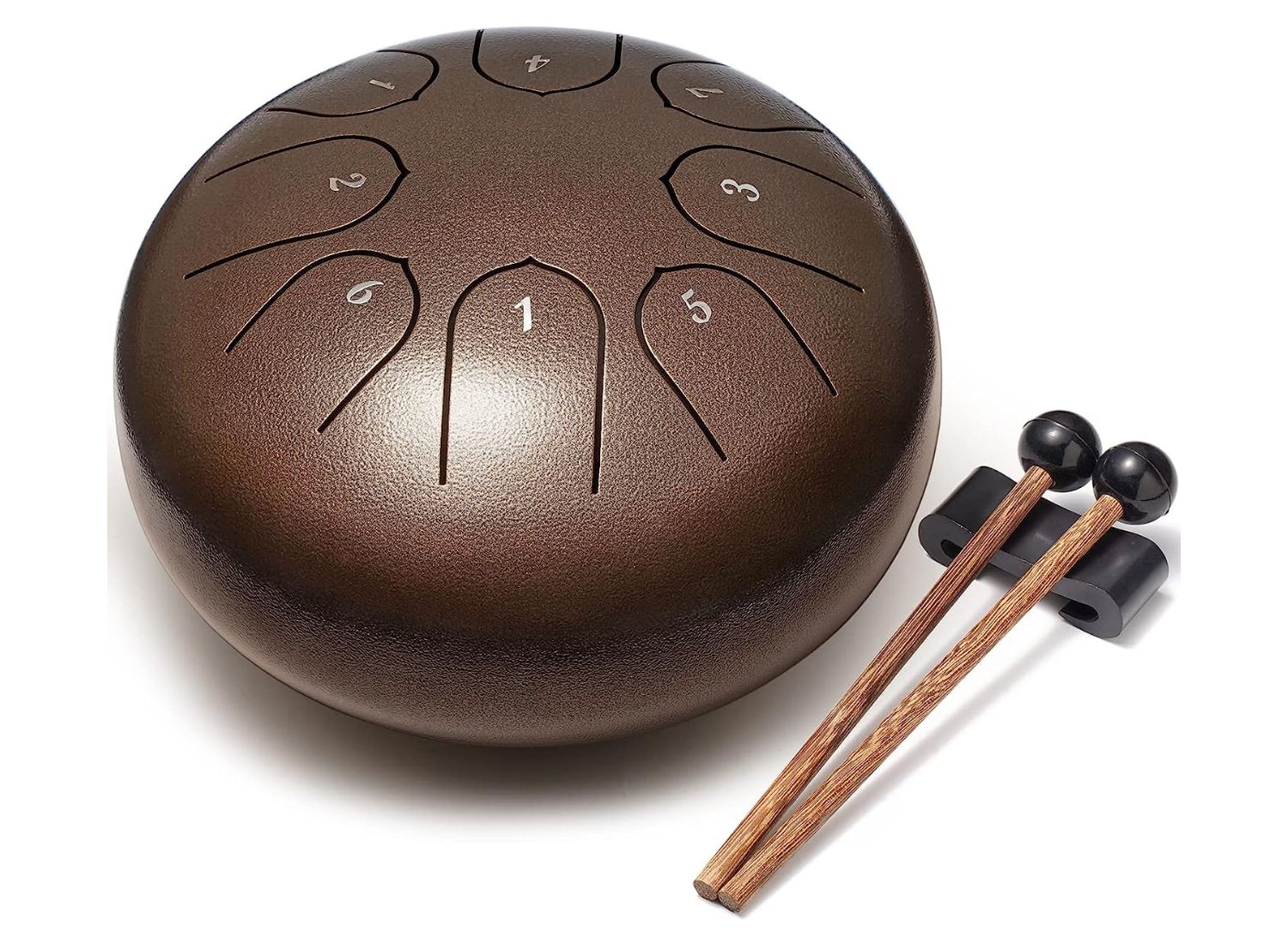
Lronbird Tongue Drum is perfect for any percussion enthusiast or musician who wants to expand their repertoire of instruments. Constructed from high-quality steel alloy, this drum has eight distinct tones that can produce beautiful ethereal and mellow sounds. The drum has been hand-modulated, meaning that each tone has been carefully tuned to produce a rich, resonant sound that’s full of depth and character.
The tongue drum comes with a sound stopper that can be opened and closed to handle different timber, allowing you to control the drum’s resonance and produce a wide range of sounds. Even better, this instrument boasts three non-slip rubber feet that help keep it stable while paying. The rubber feet also help to absorb vibrations, which helps to produce cleaner and clearer sounds. You can use it for meditation, relaxation, stress relief, or enjoyment. It’s also great for artists who want to add an exotic touch to their music!
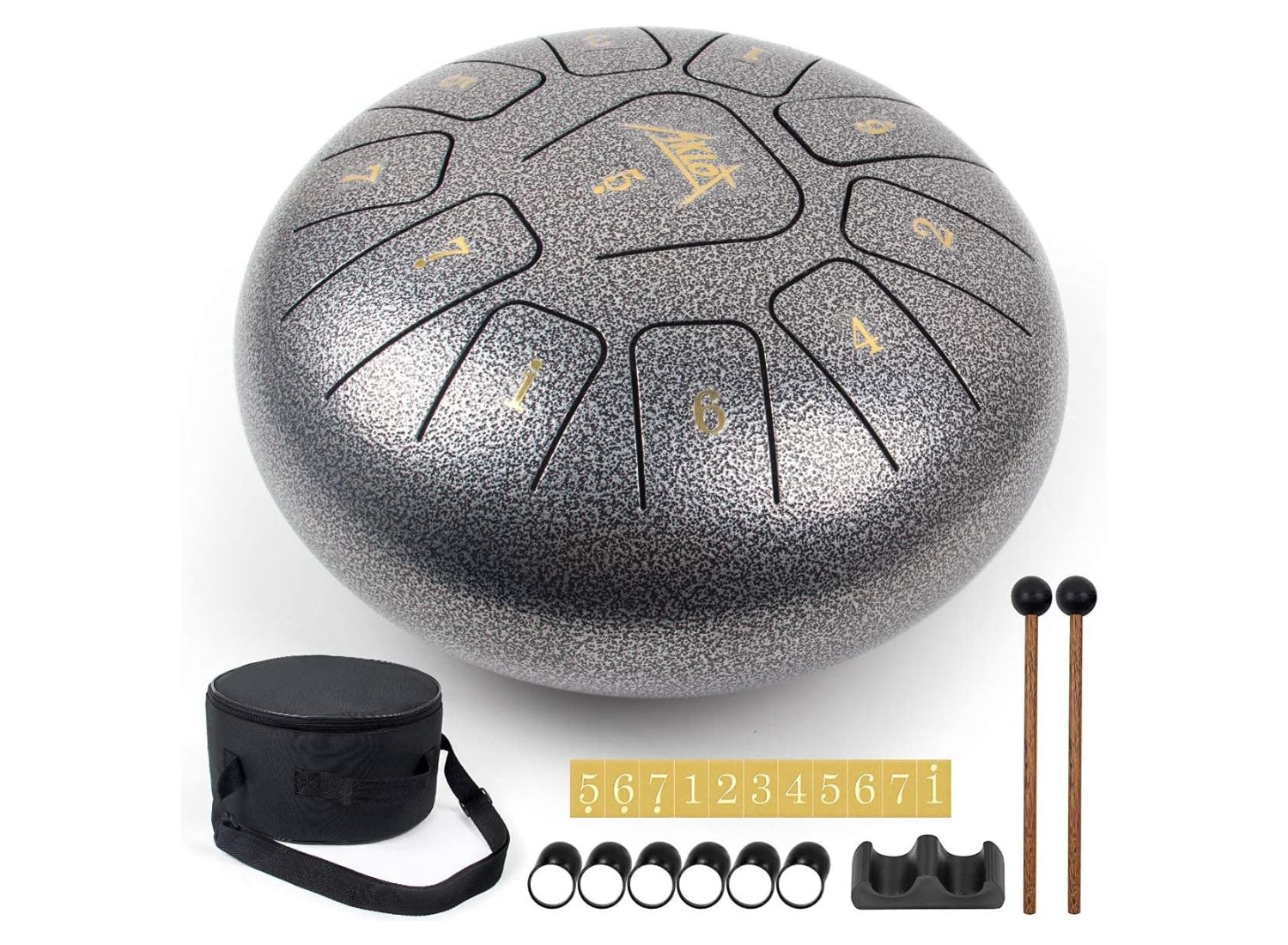
Elevate your music game with AKLOT Tongue Drum. This drum features 11 notes in the standard C key that can be used to create soothing melodies and complex riffs. Made from titanium alloy, this drum has a crisp sound that will resonate throughout any room. From religious activities to yoga meditation and other cultural ceremonies, you can use this drum to create music that will soothe your soul.
At ten inches, the drum is compact enough to fit in your bag and won’t occupy too much space. This makes it perfect for musicians who travel often and need a convenient instrument that can be played anywhere. Best of all, this pick comes with drum mallets, one mallet bracket, six finger picks, and one set of note stickers. With your purchase, you’ll also get a music book that’ll help you get your groove on!
Now that you’ve gone through our top picks, it’s time to narrow down your choices. In this buying guide, we outline the most important factors to consider when buying a tongue drum, including size and material. Let’s get started!
The number of tongues on a tongue drum can vary, with some instruments having as few as five or six tongues and others featuring over 14. Consider the range of notes you want to play and the complexity of the music you want to create when choosing the number of tongues. For example, a 5-tongued drum is best suited to playing simpler melodies, while a 14-tongued drum can produce complex polyphonic rhythms.
Tuning is an essential aspect of playing a tongue drum and is largely determined by the type and quality of the material used in the construction process. From slide-tuning screws and tuning blocks to experienced master craftsmen hand hammering tonal grooves into the steel shells, manufacturers employ numerous methods when creating these instruments. It is important to consider how you would like your instrument tuned when choosing a tongue drum, as this can have a major influence on both sound quality and playability.
The tongue drum’s material will determine its durability and sound quality. Most tongue drums are made from steel shells or wood, either as single-ply or multiple-ply construction. Each material has its own unique tonal characteristics — for example, steel shells typically produce brighter tones than those heard from wooden drums — depending on how they are tuned. Additionally, some newer models may feature hybrid constructions combining steel shells with wood elements or synthetic materials such as carbon fiber and acrylics for increased resonance and sustain.
Ideally, the shell should be thick enough to produce a full, rich sound without distorting at higher volumes or when you’re playing hard. It should also be able to withstand the pressure of playing hard without cracking or warping over time.
The bearing edge is another important consideration: some drums have metal edges, while others use synthetic materials such as rubber or plastic for added durability and protection against corrosion (especially if your drum will be exposed to water). It should also be fade- and chip-resistant, so you don’t have to worry about it deteriorating over time.
Once you’ve chosen the material, it’s time to think about the tongue drum’s size. Smaller drums tend to produce higher frequencies than larger ones but may not offer as much tonal complexity or volume.
Most beginners prefer smaller drums, which are easier to play and won’t overpower other instruments in a group setting. But if you’re looking for a deep bass tone, opt for a large tongue drum with additional resonating chambers for more sound amplification.
Before buying, it is important to check what accessories are included with the tongue drum. Most drums come with various accessories such as mallets/sticks, tuning keys, storage bags/cases, etc., which all help create a complete package that allows players to play their instrument straight away! You will also want to ensure that any included accessories are high quality and made specifically for use with this particular instrument.
A: Tongue drums are unique in their construction and sound. Unlike other percussion instruments like drums and cymbals, they produce a melodic sound rather than a rhythmic beat. The tongues or keys on the surface of the instrument are tuned to specific notes and can be played in a sequence to create melodies and harmonies.
A: A tongue drum is played by striking the tongues or keys on the surface of the instrument with your fingers, a mallet, or a drumstick. Each tongue produces a specific note or tone, and the player can create melodies and rhythms by striking different tongues in a sequence.
A: The cost of a tongue drum can vary depending on the materials used, the size of the instrument, and the brand. Generally, you can expect to pay anywhere from $200 to $1000 for a high-quality tongue drum.
A: Yes, the tongue drum is a versatile instrument that can be used to play a wide range of musical genres, including folk, jazz, rock, and contemporary music.
A: The volume of a tongue drum can vary depending on the size of the instrument and the force with which it is played. Generally, tongue drums produce a soft to moderate volume, making them ideal for indoor and outdoor settings.
A: Yes, tongue drums can be tuned to specific musical scales. Common scales used include major, minor, pentatonic, and more. Some tongue drums can even be tuned to microtonal scales, allowing for more complex and unique musical expression.
A: A tongue drum and a handpan are both percussion instruments that produce melodic tones when struck, but they have some key differences. A tongue drum typically has a simpler design, with tongues cut into a flat surface, while a handpan has a more complex, spherical shape with multiple notes on its surface. Handpans are tuned to an equal temperament scale, meaning they can be played in any key without changing the pitch. They also have a more nuanced and expressive sound than tongue drums. In contrast, tongue drums have a more primitive, raw sound that’s closer to an African or Indian percussion instrument. They can only be played in one key and require an adjustment of your tongue position to change the pitch. Tongue drums are often used in folk music and world music, while handpans are more popular in modern genres like ambient and EDM.
A: No. Tongue drums are relatively easy to play and require no prior musical training. That said, as with any musical instrument, developing good technique and practice can help improve your skills and musical expression.